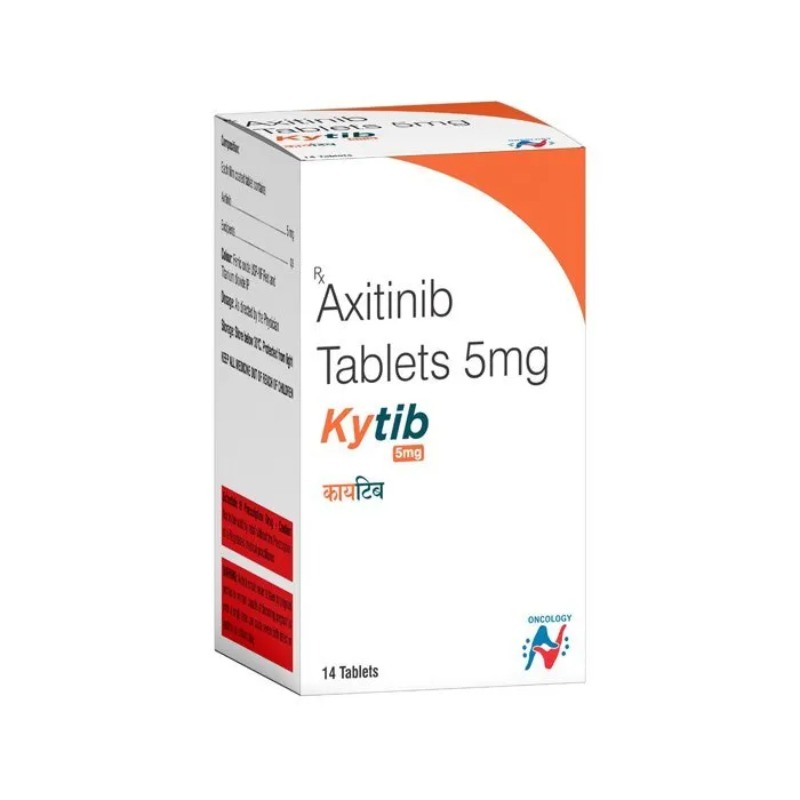DESCRIPTION
Mechanism of Action
• Small-molecule inhibitor of the ATP-binding domains of VEGFR-1,
VEGFR-2, and VEGFR-3 tyrosine kinases.
• Shows limited effects on platelet-derived growth factor (PDGFR) and
c-KIT (CD117).
• Interferes with processes involved in tumor growth and proliferation,
metastasis, and angiogenesis.
Mechanism of Resistance
• Mechanisms of resistance have not been well characterized.
• Increased expression of VEGFR-1, VEGFR-2, and VEGFR-3.
Absorption
Rapid oral absorption when given with food with a mean absolute bioavailability
of approximately 60%. Peak plasma concentrations are reached
2 to 6 hours after oral ingestion, and steady state is achieved within 2 to 3 days
of dosing.
Distribution
Volume of distribution is 160 L. Extensively bound (.99%) to albumin
and to α 1-acid glycoprotein.
Manual
A Metabolism
Metabolism is primarily in the liver by CYP3A4 and CYP3A5 enzymes
and to a lesser extent by CYP1A2, CYP2C19, and UGT1A1. Sulfoxide and
N-glucuronide metabolites are significantly less potent against VEGFR-2
compared to parent drug. Hepatobiliary excretion is the main pathway of
drug elimination. Approximately 40% is eliminated in feces, of which 12%
as unchanged drug, and 23% in the urine as metabolites. The terminal halflife
is 2 to 5 hours.
Indications
FDA-approved for the treatment of advanced renal cell carcinoma after
failure of one prior systemic therapy.
Dosage Range
Recommended starting dose is 5 mg PO bid. Dose can be increased or
decreased based on tolerability or safety. Dose increase—If dose is tolerated
for at least 2 consecutive weeks, dose can be increased to 7 mg PO bid, then
up to 10 mg PO bid. Dose reduction—To minimize the risk of adverse
events, the dose can be decreased to 3 mg PO bid, then to 2 mg PO bid.
Drug Interaction 1
Drugs such as ketoconazole, itraconazole, erythromycin, clarithromycin,
atazanavir, indinavir, nefazodone, nelfinavir, ritonavir, saquinavir, telithromycin,
and voriconazole may decrease the rate of metabolism of axitinib,
resulting in increased drug levels and potentially increased toxicity.
Drug Interaction 2
Drugs such as rifampin, phenytoin, phenobarbital, carbamazepine, and
St. John’s Wort may increase the rate of metabolism of axitinib, resulting in
its inactivation.
Drug Interaction 3
Proton pump inhibitors, H2-receptor inhibitors, and antacids—Drugs
that alter the pH of the upper GI tract may alter axitinib solubility, thereby
reducing drug bioavailability and decreasing systemic drug exposure.
Special Considerations
1. No dose adjustment is needed for patients with CrCl .15 mL/min.
However, caution should be used in patients with end-stage renal
disease.
2. Dose adjustment is not required in patients with mild hepatic
impairment. The dose of axitinib should be reduced by 50% in
patients with moderate impairment (Child-Pugh Class B). Axitinib
has not been studied in patients with severe hepatic impairment
(Child-Pugh Class C).
3. Axitinib should be taken approximately 12 hours apart with or without
food and should be taken with water.
4. Patients should be warned of the increased risk of arterial thromboembolic
events, including myocardial ischemia and stroke.
5. Patients should be warned of the increased risk of venous thromboembolic
events, including deep vein thrombosis (DVT) and pulmonary
embolism (PE).
6. Blood pressure should be well controlled prior to starting axitinib
therapy. Closely monitor blood pressure while on therapy and treat as
needed with standard oral antihypertensive medication.
7. Axinitib therapy should be stopped at least 24 hours prior to scheduled
surgery.
8. Closely monitor thyroid function tests and thyroid-stimulating
hormone (TSH), as axitinib therapy results in hypothyroidism.
9. Closely monitor LFTs and serum bilirubin while on therapy.
10. Avoid Seville oranges, starfruit, pomelos, grapefruit, and grapefruit
products while on therapy.
11. Pregnancy category D. Breastfeeding should be avoided.
Toxicity 1
Hypertension occurs in 40% of patients and usually within the first
month of treatment.
Toxicity 2
Increased risk of arterial and venous thromboembolic events.
Toxicity 3
Bleeding complications.
Toxicity 4
GI perforations and wound-healing complications.
Toxicity 5
Diarrhea, nausea/vomiting, and constipation.
Toxicity 6
Proteinuria develops in up to 10% of patients.
Toxicity 7
Hypothyroidism.
Toxicity 8
Elevations in SGOT/SGPT and serum bilirubin.
Toxicity 9
Reversible posterior leukoencephalopathy syndrome (RPLS) occurs rarely
(,1%) and presents with headache, seizure, lethargy, confusion, blindness,
and other visual disturbances.
SPECIFICATION


Login To Comment